A Basic Indian Curry Powder, or masala mix, requires just a handful of ingredients that you probably already have in your pantry. This is a quick guide to help you create your own homemade spice blend so you can make your favorite curry recipes at home anytime you'd like. Homemade curry powders beats any store-bought blends or commercial curry powders.

Jump to:
- What's curry powder and how did it get its name
- What's in a curry powder
- South Indian curry powder (Madras curry powder)
- Biryani powder
- Garam masala powder
- Quick substitute for curry powder in a recipe
- Why you'll love this Indian masala mix
- Recipe ingredients
- Ingredients notes
- How to make this basic Indian curry powder step by step
- Frequently asked questions (FAQs)
- Sourcing unusual ingredients
- How to make a Basic Curry Powder (Indian Masala Mix)
What's curry powder and how did it get its name
First off, let's address the elephant in the room: No, there's no such thing as a "curry powder". "Curry powder" is a British term coined back when they occupied India during the 18th and 19th centuries.
Indian curry powder is a catch-all term for spice blends, no matter what spices the blend is composed of. It would be more accurate to call them homemade masala blends or mixes. Masala means spice in Hindi and literally every Indian home could have their own blend for each dish.
The word "curry" is derived from the word "kari", which is Tamil for any sauce or vegetable dish. To an Indian, curry would be primarily associated with a dish that has gravy but to everyone else, it could be any savory dish that contains a number of spice blends. Naturally, in India, there's an endless number of gravy-based dishes, both vegetarian and non-vegetarian.
To oversimplify what transpired, basically, when the British occupied India, they amalgamated all those dishes into the word "curry". And to make any number of curry dishes, you need a blend of spices, which they referred to as curry powder.
Traditional Indian cooking doesn't constrict itself within the confines of this modern term. In essence, it's a Western interpretation approximating the endless masala spice blends of North and South India.
Blend of spices = curry powder
Curry powder = any blend of spices
The term "curry powder" would be quite puzzling to anyone from the land of spices. Seeing how the Indian subcontinent is home to 1.4 billion people with over 120 languages, the term curry powder is a bit diminutive, but the term stuck. Not to say that it's not practical or relatively befitting, but it's reductive nevertheless.
For simplicity's sake, let's use this term curry powder throughout this blog.
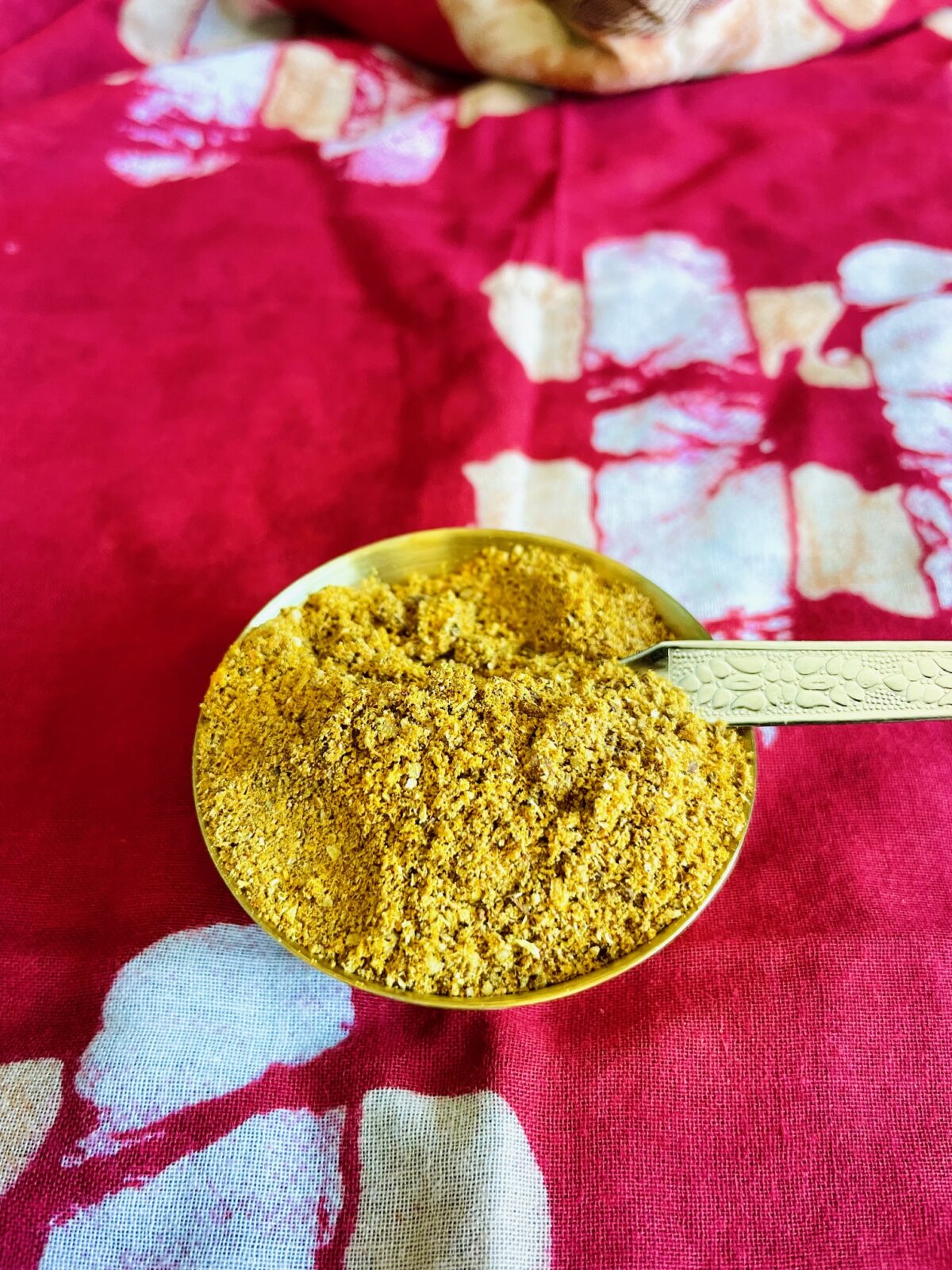
What's in a curry powder
To make a curry powder, you would ideally start with whole spices or whole seeds, but if all you have at home are individual ground spices, that's okay in a pinch! As previously mentioned, any mix of spices used in Indian cuisine is a curry powder or masala mix. The ground spices used in Indian masala mixes differ from region to region.
Most common ingredients in curry powder include a base of the following:
- Coriander
- Cumin
- Brown mustard
- Cinnamon
- Black peppercorns
- Red chilies or paprika
- Turmeric
- Ginger
Other ingredients might include the following:
- Asafoetida (or hing)
- Cardamom - green (sometimes black)
- Curry leaves
- Fennel seeds
- Fenugreek seeds
- Nutmeg
- Star anise
South Indian curry powder (Madras curry powder)
Madras is modern-day Chennai, the capital city of the Southernmost state of Tamil Nadu. In South India, the masala mix often contains dal (lentils) or rice, which gives their curry a nice texture.
South Indian curries generally have a little more tang (from the addition of garcinia indica, aka kokum) and a little more heat (from black pepper and spicy red chili peppers).
The most common dals used in South Indian curry powders are:
- Black dal (urad dal)
- Pigeon peas (toor dal)
- Chickpeas (chana dal)
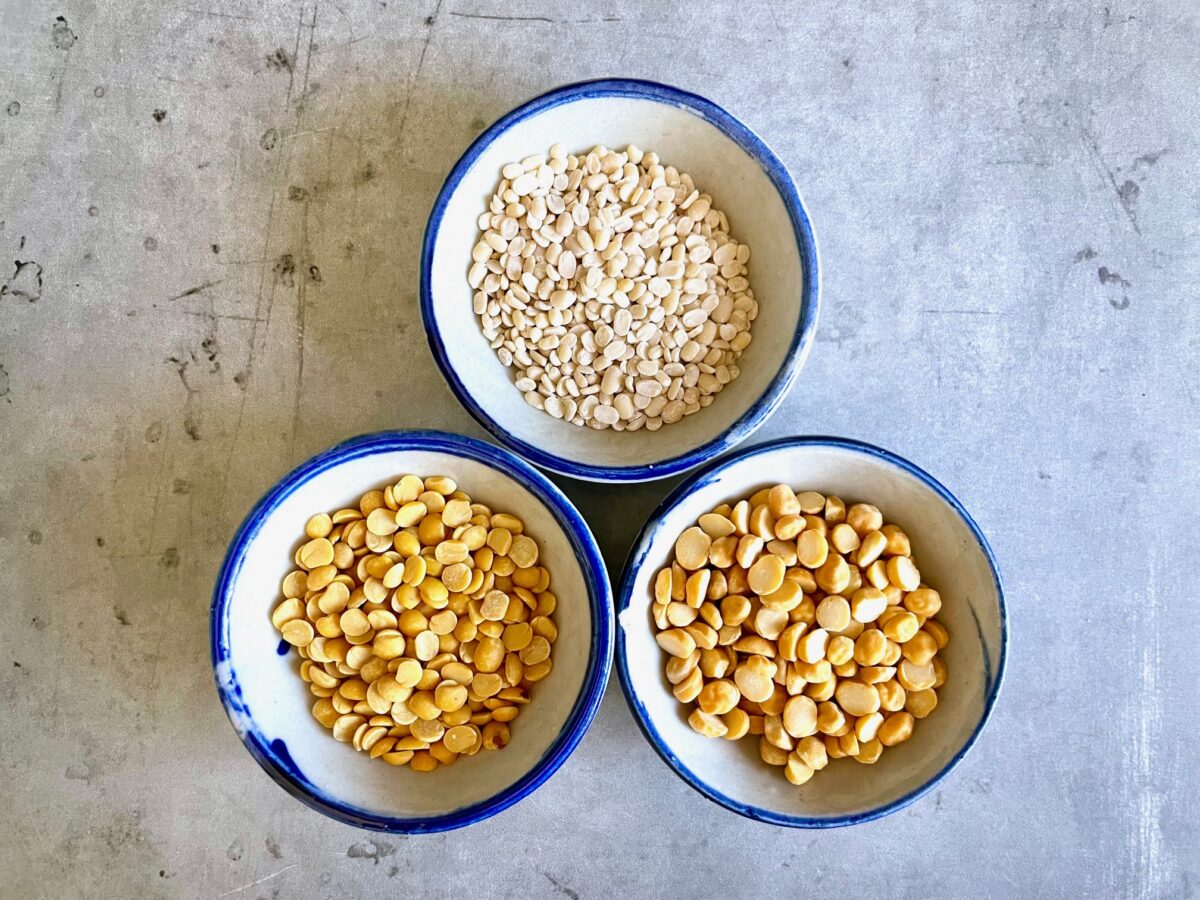
From top to bottom and left to right: urad dal, pigeon peas, chickpeas.
Biryani powder
In addition to the ingredients in a basic curry powder, a biryani masala mix could also include the following spices:
- Marati moggu (Indian capers)
- Poppy seeds (black or white)
- Star anise (also called biryani flower)
- Stone flowers (edible lichen that grows on trees and rocks)
- Saffron
Garam masala powder
Garam masala is not necessarily a curry powder in the real term, but it is a combination of specific warming (garam means "hot") spice blends that contain the following spices:
- Coriander seeds
- Cumin seeds
- Cinnamon sticks
- Cardamom pods
- Cloves
- Black peppercorns
Optional garam masala additions:
- Black cardamom (smoked dried cardamom)
- Fennel seeds
- Indian bay leaf (no relation to laurel bay leaf)
- Mace
- Nutmeg
- Star anise
Quick substitute for curry powder in a recipe
If you don't have the individual spice powders to make a basic curry seasoning blend, you can use base spices in garam masala, namely coriander, cumin, cinnamon, cardamom, cloves, and black pepper, along with one teaspoon of turmeric.
If you don't have any of the individual spices mentioned, just use what you have and remember that in India, they use what they have, whether regionally or at home. Make it your own!
Substitute for curry powder = garam masala + 1 teaspoon of turmeric
Also, have a look at the ingredients list for a basic Indian curry powder recipe in the Recipe Ingredients section. Just use any spices that you have at home from that list and bear in mind that they are in rough order of importance and quantity.
Note: If you're planning on making Indian dishes on a rotation at home, it's best to have all the basic spices and pantry items on hand and to get an understanding of the ingredients used.
If you've ever wondered about the difference between Cumin vs Curry, you might enjoy my article about the key differentiators and the main uses for each of them!
From left to right: Cumin seeds and whole spices for curry powder.
Why you'll love this Indian masala mix
- Super basic. This recipe uses very simple ingredients in an effort to give you the best-tasting curries with the least amount of spices to recreate typical Indian flavors.
- Make it more interesting. I guide you on how to tweak this easy Indian curry powder recipe to match your taste and make it more exciting. For instance, if you're making South Indian-style curry, you might want to add a hot red chili powder like cayenne pepper instead of paprika, and even incorporate some urad dal!
- Versatile spice blend. You can use this basic curry powder to recreate your favorite Indian dishes, like a chicken curry. But it can also be sprinkled in dishes that aren't curries, like roasted vegetables and soups.
- Increase the heat level. This is a recipe for a mild curry powder mix. You can increase the heat level by using cayenne powder, or whichever hot chili powder you like, or just double the amount of chili powder!
Recipe ingredients
You'll need the following ingredients to make this basic Indian curry powder:
- 3 tablespoons coriander seeds
- 4 teaspoons cumin seeds
- 1 teaspoon brown mustard seeds
- 1/2 inch cinnamon stick
- 2 whole red chilies, deseeded and hand-torn into small pieces
- 1/4 teaspoon black peppercorns
- 2 teaspoons turmeric powder
- 1/2 teaspoon ginger powder
- 1 teaspoon fennel seeds (optional but recommended)
- 1 teaspoon fenugreek seeds (optional but recommended)
- 2 cardamom pods (optional)
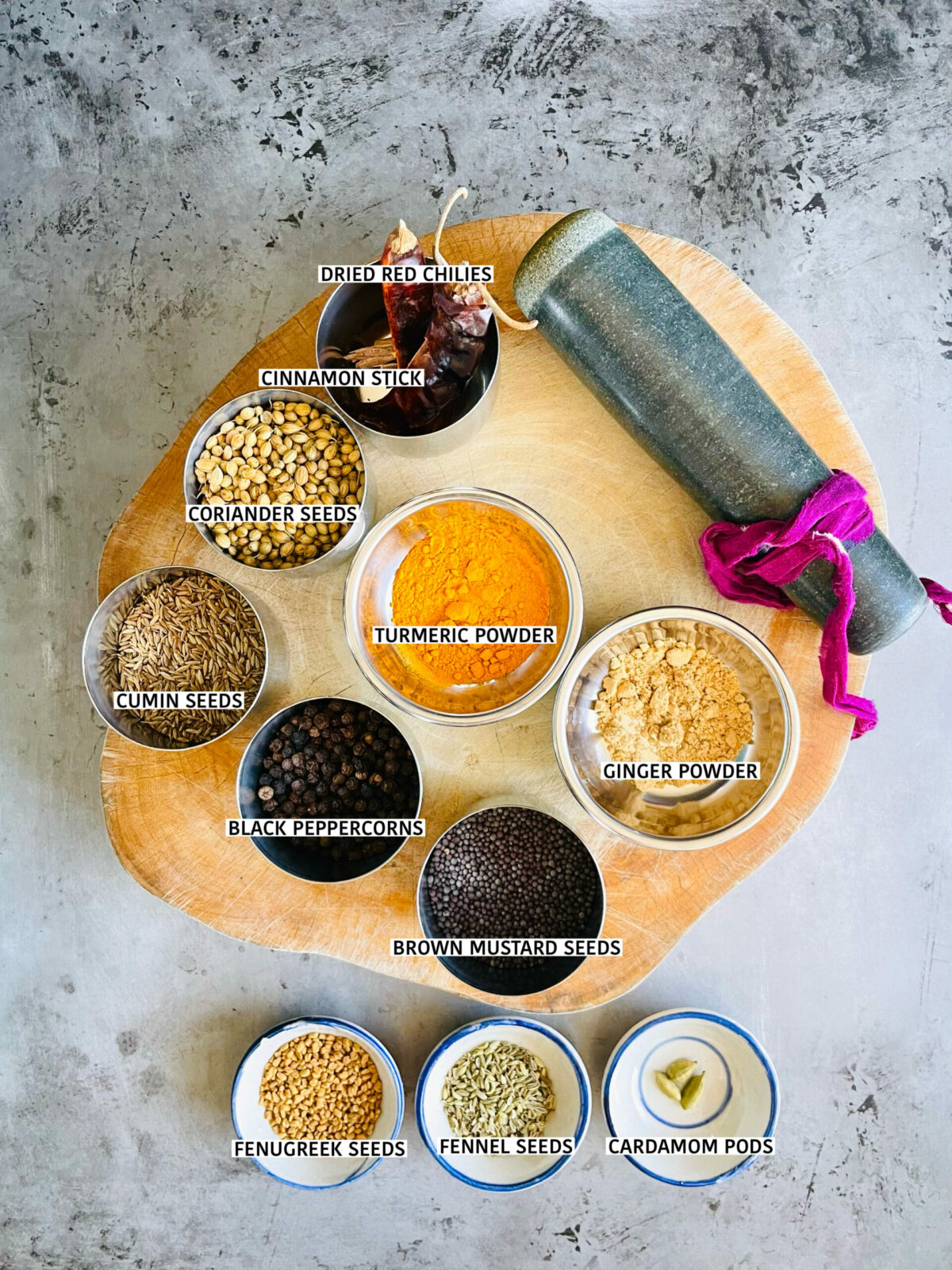
Ingredients notes
Whole red chilies. There are a variety of whole red chilies or chili powders that you can use in your mix. I would recommend Kashmiri chili or any other Indian chilies. Since some of them might be hard to source if you don't have an Indian store nearby or Amazon doesn't deliver in your area, I'll list the chilies in order of spice level.
- Byadgi chili. This is a mild chili, most common in South Indian cuisine.
- Kashmiri chili. It has a deep red color, low-to-medium spice level, and gives a rich color and taste to dishes. This is the reason why many Chefs pick Kashmiri red chilies over any other chilies in their recipes.
- Cayenne. Cayenne pepper is not Indian but it's commonly available worldwide and is the closest to Indian chilies in terms of heat. It marries with Indian dishes really well.
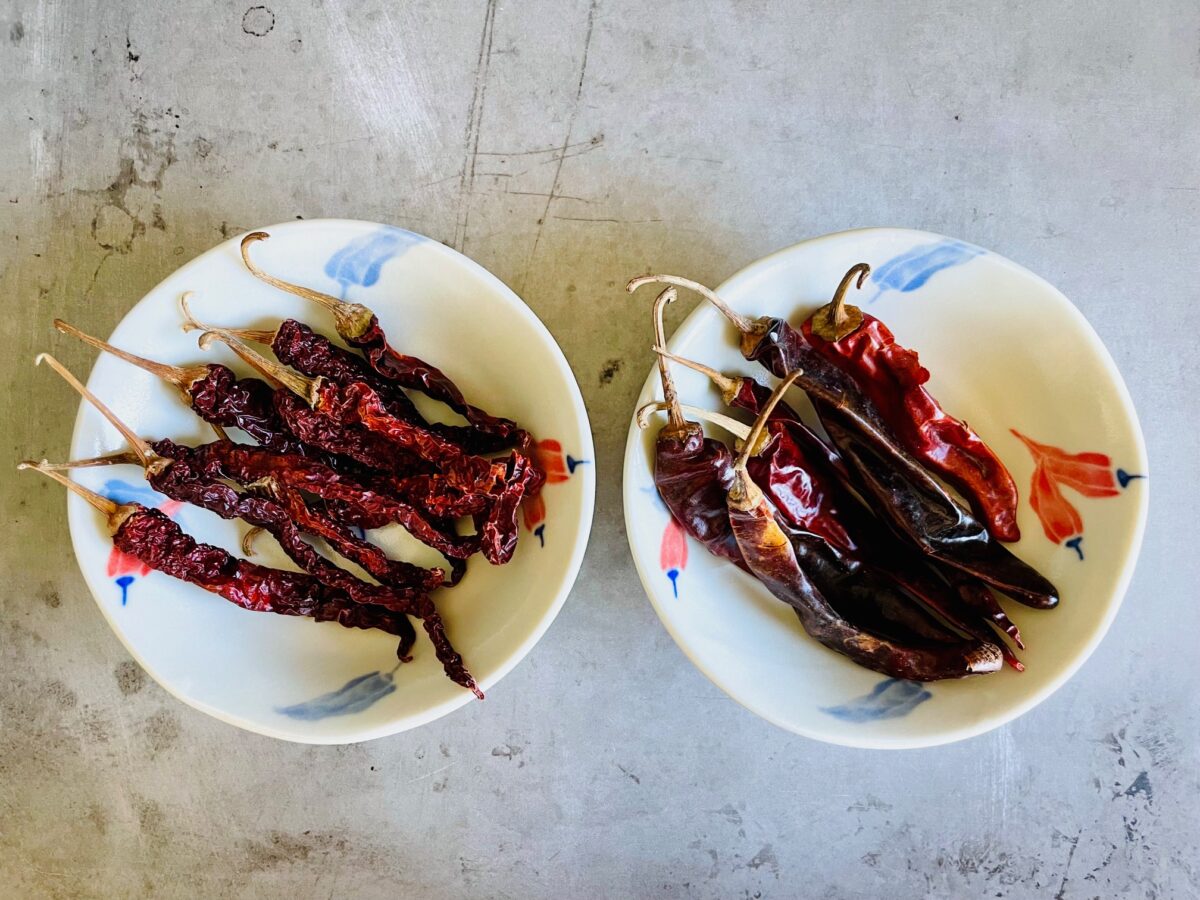
From left to right: Byadagi chili (South Indian) and Kashmiri chili (North Indian)
I don't recommend using dried habanero powders or other Mexican red chilies with a distinct Latin flavor for Indian recipes. They aren't too similar to Indian chilies. However, in a pinch, use whatever chili powder you already have at home.
Fenugreek seeds, fennel seeds, and cardamom pods. If you're able to source fenugreek seeds or powder, I highly recommend adding them. They'll impart a more authentic taste to Indian dishes. Fennel and cardamom are also really great additions as well.
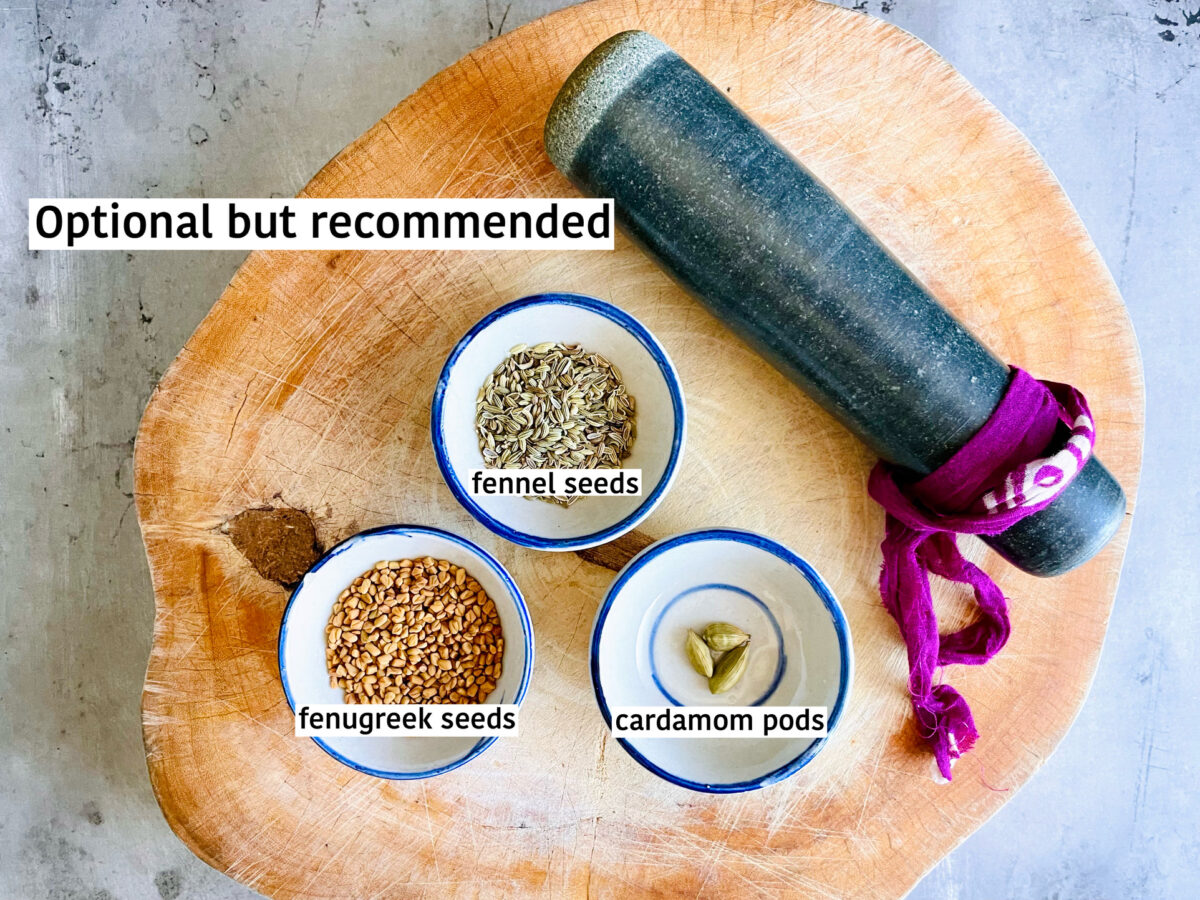
How to make this basic Indian curry powder step by step
STEP 1. Heat a medium pan over medium heat; add the whole spices (so don't add any spice powders at this stage) and hand-torn dried red chilies. Dry roast until they start to darken and release their beautiful aroma.
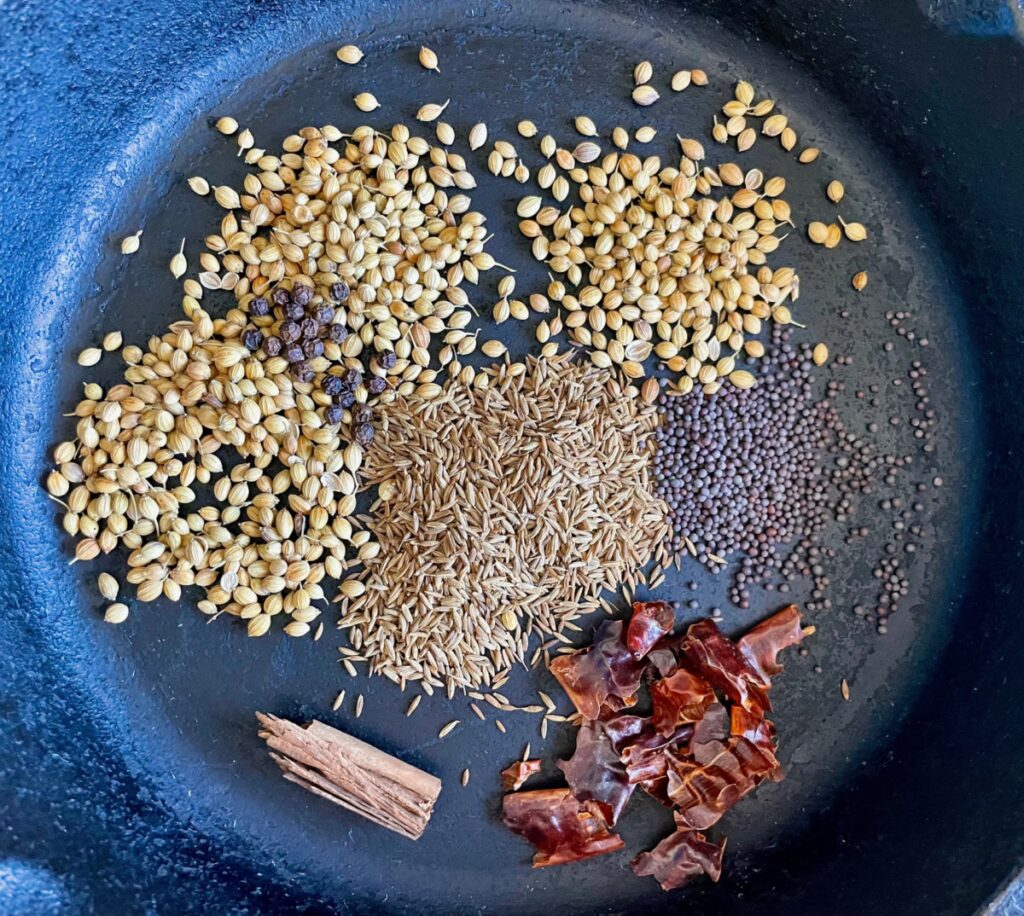
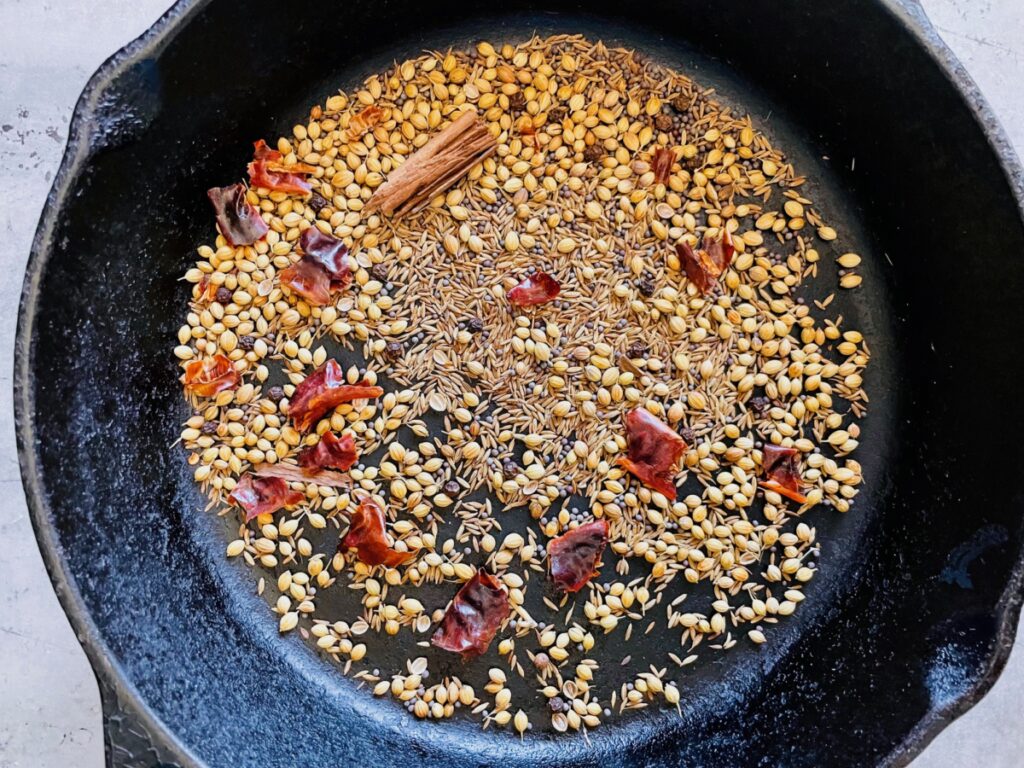
STEP 2. Remove from heat and let cool completely before grinding to a powder (fine or coarse, your choice). You can use any of the following to grind your spices: coffee grinder, blender, or mortar and pestle. I prefer to use a coffee grinder.
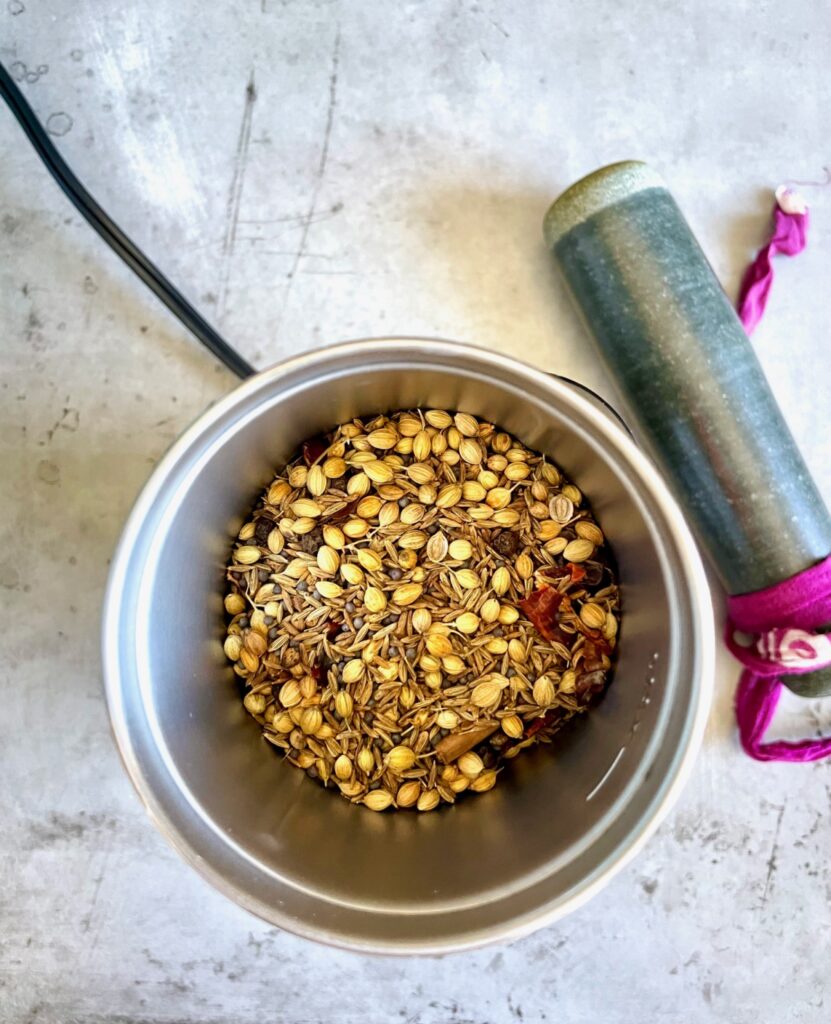
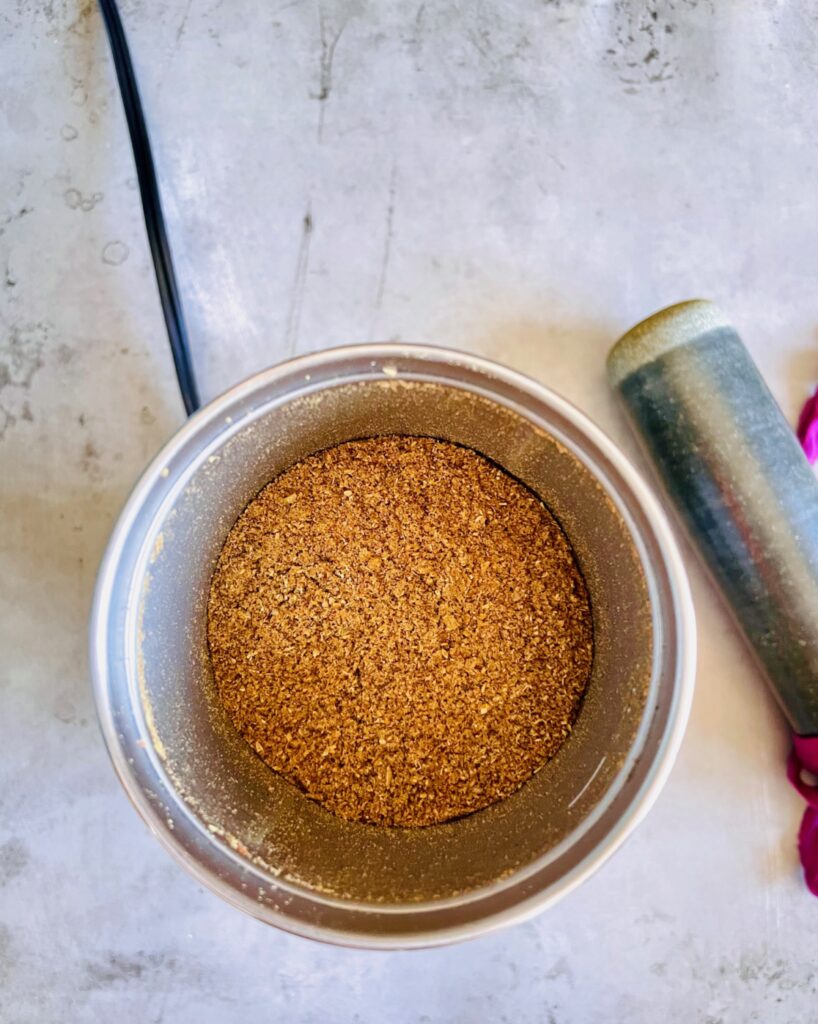
STEP 3. In a small mixing bowl, mix the freshly ground spices with the turmeric powder, ginger powder, and whatever spice powders you're personally adding to the mix.
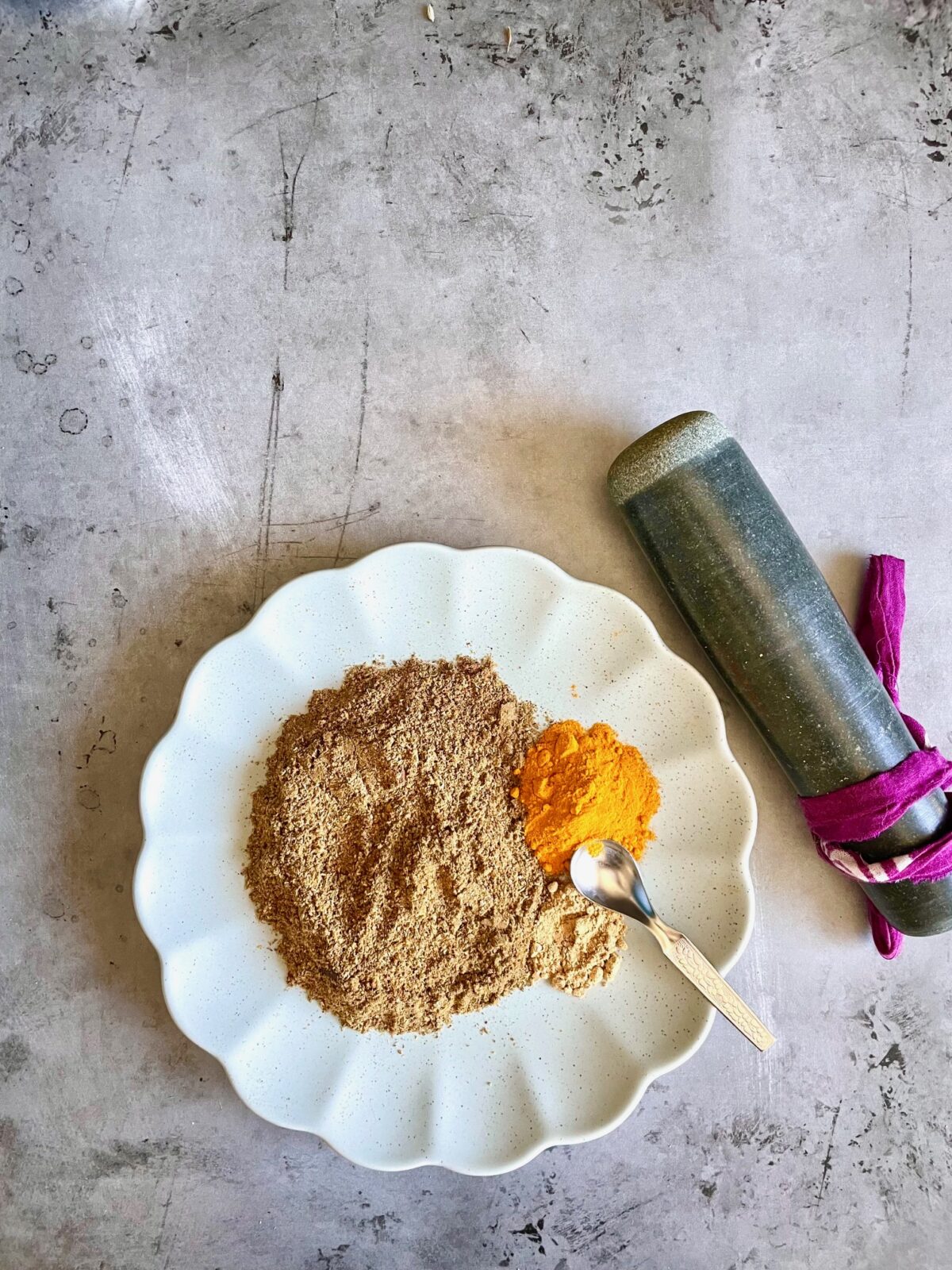

STEP 4. Store in an airtight jar or container and keep in a cool dark place.
Frequently asked questions (FAQs)
Spices need to be kept away from heat, sunlight, humidity, and air as much as possible. So store your spices and freshly prepared curry powder in an airtight jar and keep them away in a cool dry place like a dark cupboard.
If stored properly, whole spices can last up to a year, and individual spice powders or curry powder blends are good for 6-8 months.
To lend an extra Indian flair to your curry powder blend, I highly recommend using fenugreek seeds, fennel seeds, and cardamom pods!
If you're going for a South Indian-style dish, add additional red chili powder and additional black pepper and some dal/lentil (urad dal, toor dal, or chana dal).
Dried coconut flakes and curry leaves are also great additions. Scroll up in the South Indian Curry Powder section for more ideas.
Sourcing unusual ingredients
Fenugreek seeds (methi)
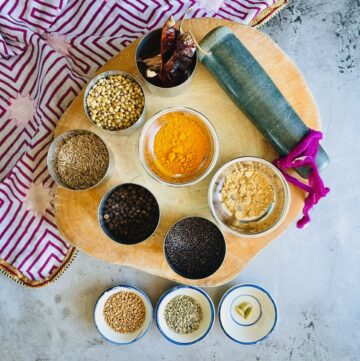
How to make a Basic Curry Powder (Indian Masala Mix)
Equipment
- 1 coffee grinder or spice grinder
Ingredients
Whole spices
- 3 tablespoons coriander seeds or 2¼ tablespoons coriander powder
- 4 teaspoons cumin seeds or 3 teaspoons cumin powder
- 1 teaspoon brown mustard seeds or ¾ mustard powder (yellow is okay in a pinch)
- ½ inch cinnamon stick or ⅓ teaspoon cinnamon (Ceylon cinnamon preferred)
- 2 whole red chilies or ¾ teaspoon chili powder (Kashmiri chili preferred, but other dried red chilies are okay)
- ¼ teaspoon black peppercorns or ¼ teaspoon black pepper powder
Spice powders
- 2 teaspoons turmeric powder
- ½ teaspoon ginger powder
Optional but recommended
- 1 teaspoon fenugreek seeds or ¾ teaspoon fenugreek powder
- 1 teaspoon fennel seeds or ¾ teaspoon fennel powder
- 2-3 cardamom pods or ¼ teaspoon cardamom powder
Instructions
Toast the whole spices
- Heat a medium pan, preferably cast iron, over medium heat. Add the whole spices to the pan: coriander seeds, cumin seeds, brown mustard seeds, cinnamon stick, hand-torn red chilies, black peppercorn, and the optional fenugreek seeds, fennel seeds, and cardamom seeds.
- Dry roast the spices and gently stir them every so often until they start to darken and release their beautiful aroma, about 30 to 60 seconds. Remove pan from the heat and set the toasted spices aside to cool completely.
Grind the spices
- Transfer the toasted spices into a coffee grinder and grind into a powder (fine or coarse). You can also use a mortar and pestle or blender if you don't have a coffee grinder.
Mix in the turmeric and ginger powders
- Transfer the toasted spice powders to a small mixing bowl and add in the turmeric powder and the ginger powder. Mix with a small whisk until everything is evenly blended.
Store
- Transfer your Indian curry powder into an airtight jar or container. Keep it in a cool dark place like a cupboard. This is good for about 6 months.
Notes
If you love Indian cuisine, you might like to my Typical Bengali Moong Dal recipe and the quintessential Everyday Cucumber Raita. They're both easy to make and perfect for week night dinners!

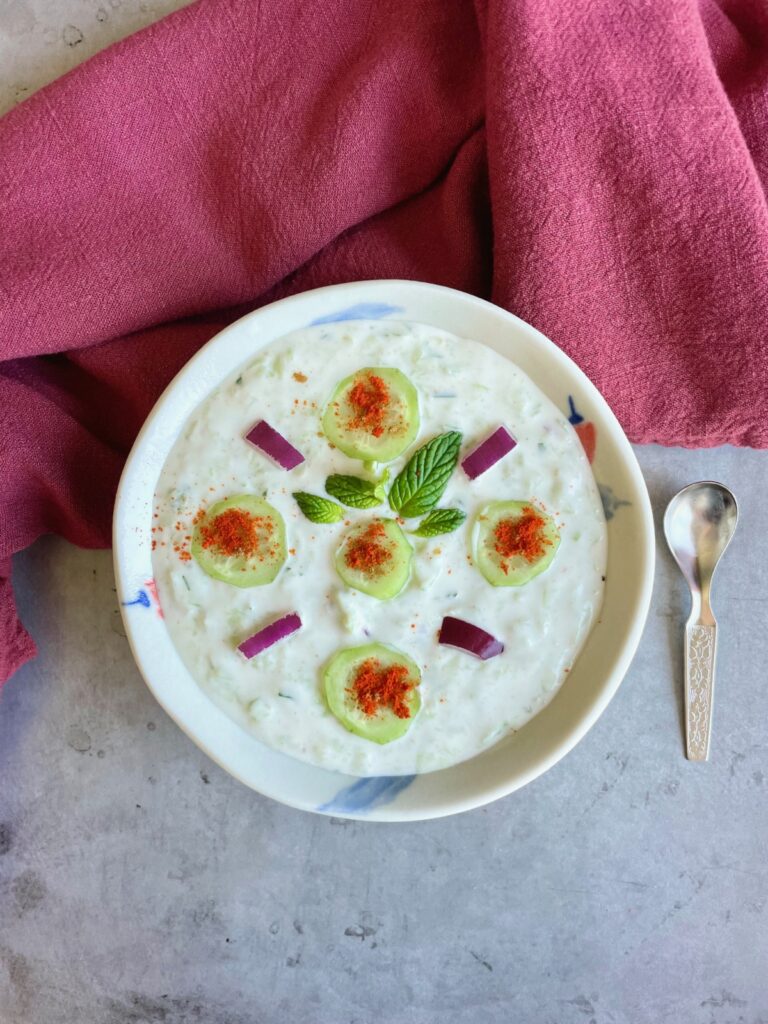
You might also like to check my Mauritian Curry Powder recipe. It's not too different from this basic Indian curry powder. It contains curry leaves, which will give your curry a bit of a South Indian twist.
If you've enjoyed this post and recipe or have any questions, please leave me a comment below. I would love to hear from you!


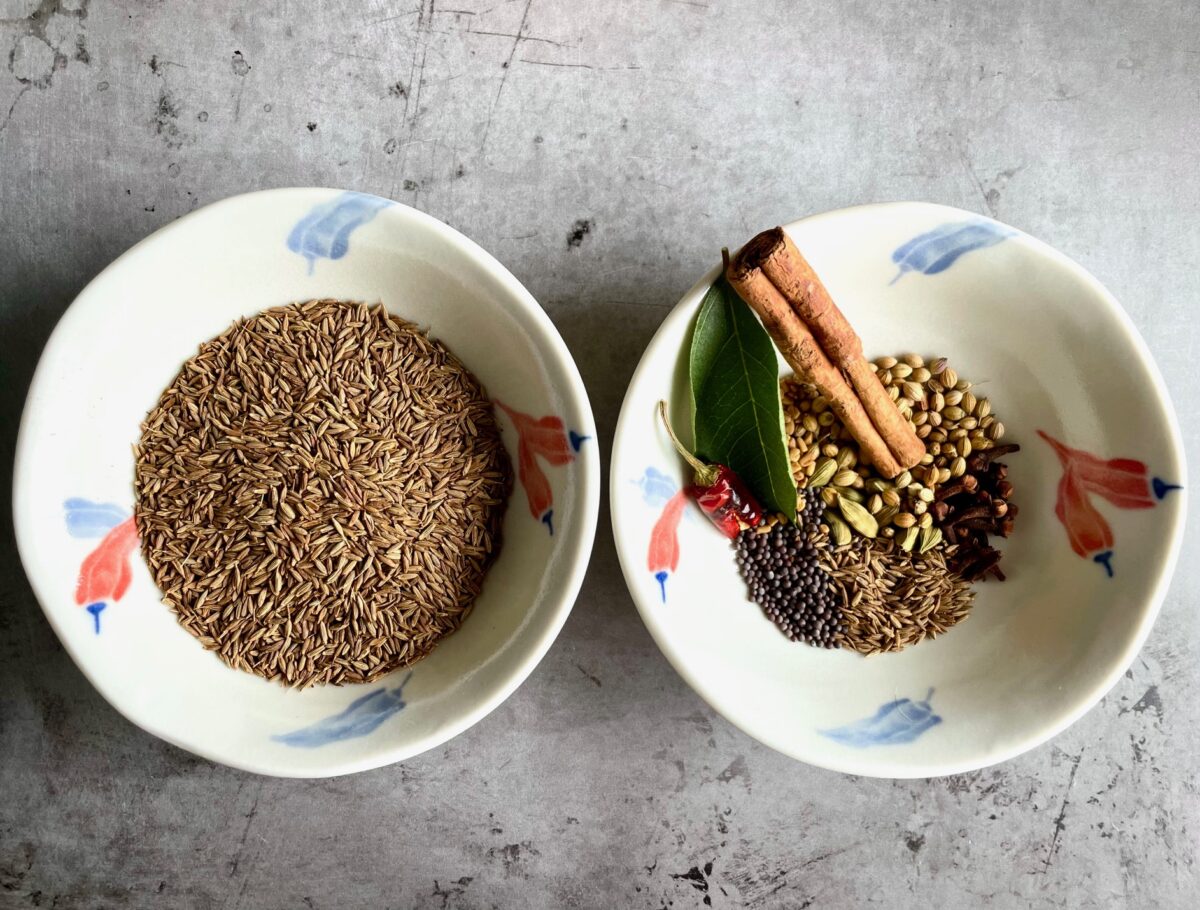
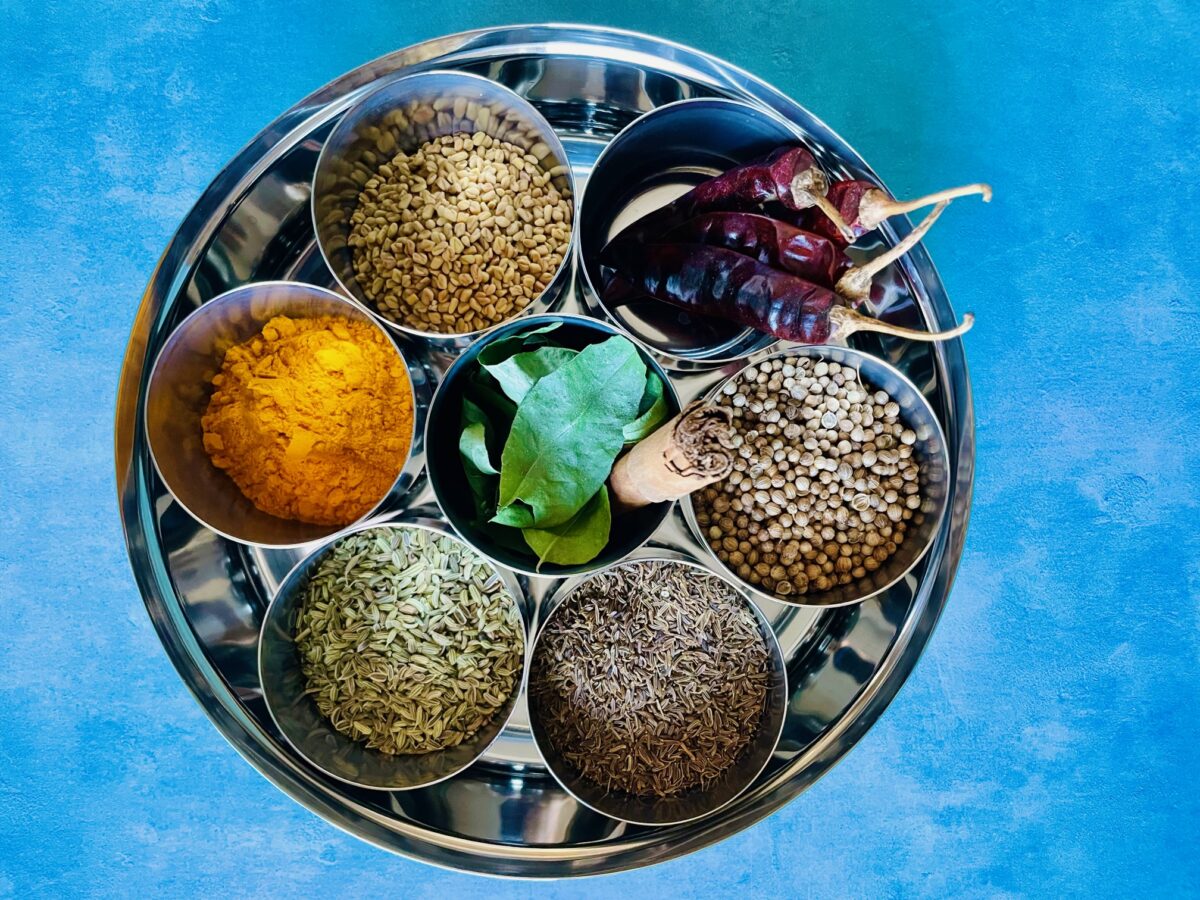
Leave a Reply